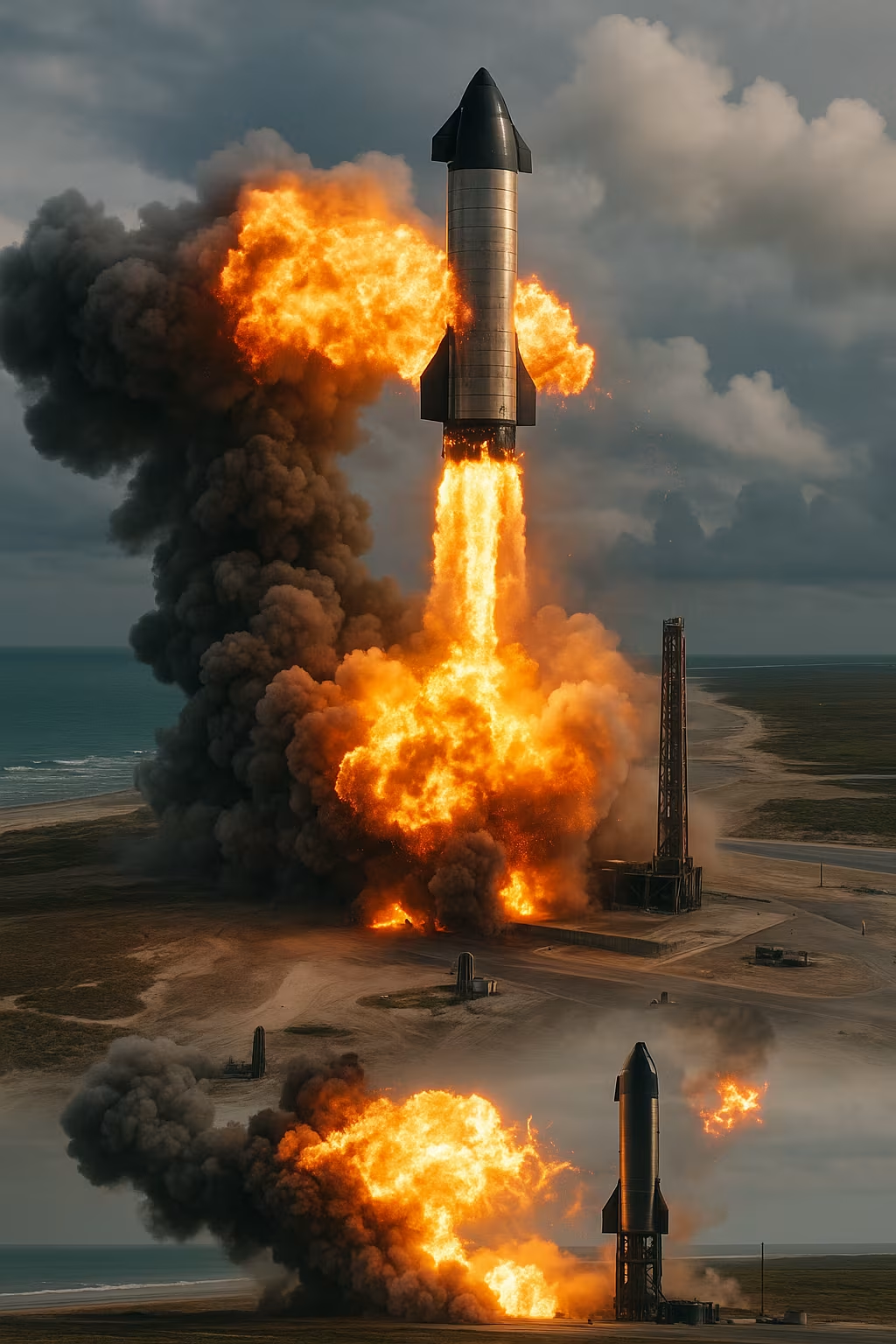SpaceX’s Starship program — Elon Musk’s flagship project to enable human settlement on Mars — has hit yet another obstacle. The fourth consecutive Starship rocket test ended in an explosion shortly after launch, adding to a string of public and costly setbacks for Musk’s boldest space ambition.
The incident, while not entirely unexpected in the experimental phase, raises questions about timelines, investor confidence, and the feasibility of Musk’s aggressive vision to make humanity multiplanetary within the coming decades.
1. The Ambition Behind Starship
Starship is SpaceX’s fully reusable next-generation spacecraft, designed to carry up to 100 passengers or more than 100 tons of cargo to destinations including the Moon, Mars, and beyond. Standing nearly 400 feet tall when stacked with its Super Heavy booster, it’s the largest and most powerful rocket ever built.
The program’s goals are nothing short of revolutionary: to dramatically lower the cost of space travel, enable frequent interplanetary missions, and ultimately make colonization of Mars achievable within Musk’s lifetime.
2. What Happened in the Latest Test
In the most recent test flight, Starship successfully ignited its massive Raptor engines and cleared the launch tower in a dramatic display of power. But just minutes into the flight, a malfunction triggered a rapid unscheduled disassembly — aerospace jargon for a catastrophic failure.
Early data suggests the problem may have originated in the booster stage, which suffered a loss of pressure, triggering the onboard flight termination system. The spacecraft broke apart, scattering debris over the Gulf of Mexico and leaving engineers scrambling to determine the root cause.
3. A Pattern of High-Risk Testing
This is the fourth consecutive Starship test to end in an explosion, either during ascent or reentry. Previous attempts saw a range of issues — from fuel leaks and engine failures to structural weaknesses during atmospheric descent.
SpaceX has long embraced a “fail fast, learn faster” philosophy, treating each test flight as a data-gathering opportunity rather than a binary success or failure. While this approach has paid off in past programs like the Falcon 9, the public and repeated nature of these Starship setbacks makes them harder to shrug off.
4. Impact on the Mars Timeline
Musk has repeatedly stated that the first uncrewed Starship mission to Mars could launch as early as the late 2020s, with crewed missions following shortly after. But with each failed test, those timelines become increasingly difficult to believe.
For Starship to be mission-ready, SpaceX needs to demonstrate not just a successful launch, but also safe stage separation, orbital insertion, and — most importantly — reusability. The program’s Mars ambitions also hinge on proving in-orbit refueling, long-duration life support, and safe reentry from interplanetary speeds. None of those milestones have been reached yet.
5. NASA’s Lunar Plans Could Also Be Affected
Beyond Mars, Starship is a key component of NASA’s Artemis program, which aims to return astronauts to the Moon later this decade. SpaceX won the contract to develop a lunar lander version of Starship, designed to ferry astronauts from lunar orbit to the surface and back.
While NASA officials have expressed confidence in SpaceX’s ability to deliver, continued high-profile failures could pressure the agency to consider backup options — especially with political and budgetary scrutiny already high.
6. Financial Stakes and Investor Confidence
Starship’s repeated explosions are more than just engineering challenges — they’re financial ones. Each test flight costs tens of millions of dollars, not including the years of development work that precede it.
While SpaceX is privately held and benefits from a robust launch business with its Falcon 9 rockets and Starlink satellite network, the Starship program represents a massive and risky investment. Delays and failures could impact future fundraising efforts, particularly if investors grow concerned about the return on such a long-term bet.
7. Public Perception and Musk’s Reputation
Elon Musk has built his career on bold promises and eventual delivery, but his Mars vision is perhaps his most audacious pledge yet. Frequent Starship explosions, broadcast live to millions, risk eroding public confidence in his spacefaring ambitions.
Critics argue that the repeated failures show a lack of readiness for such high-stakes missions, while supporters counter that every major aerospace breakthrough — from the Apollo program to the Space Shuttle — faced numerous setbacks in development.
8. The Engineering Road Ahead
SpaceX engineers now face the dual challenge of diagnosing the latest failure while implementing fixes from previous ones. Likely areas of focus include:
- Improving booster reliability and fuel system stability
- Strengthening thermal protection systems for reentry
- Enhancing stage separation mechanisms
- Fine-tuning the Raptor engines for consistent performance
Given the scale of Starship, even small technical issues can have catastrophic consequences. This makes incremental progress essential — but also slow.
9. Why SpaceX Will Keep Pushing
Despite the setbacks, SpaceX is unlikely to slow down testing. Musk has repeatedly said that multiple prototypes are already under construction, allowing rapid turnaround between flights. The company’s Texas launch facility at Boca Chica is equipped for continuous development, and SpaceX’s engineering culture thrives on high-speed iteration.
For Musk, every explosion is simply another step toward eventual success. “If you’re not failing, you’re not innovating enough,” he has said — a mantra that underpins SpaceX’s willingness to risk spectacular public failures in pursuit of breakthroughs.
Starship’s fourth straight explosion is a stark reminder of how difficult — and expensive — space exploration can be. Musk’s dream of sending humans to Mars remains one of the most ambitious engineering projects in history, but the path forward will be measured in years, not months.
While SpaceX’s aggressive testing approach has propelled it to the forefront of the aerospace industry, the company must now balance its appetite for risk with the need to deliver tangible, repeatable successes. Until then, Mars will remain a distant horizon — both literally and figuratively.





